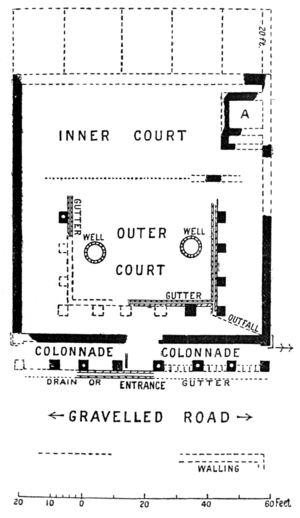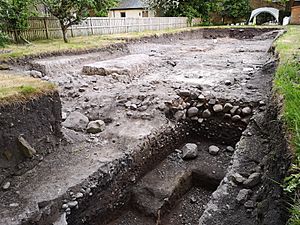Bremetennacum facts for kids
Quick facts for kids Bremetennacum |
|
|---|---|

Roman ruins in Ribchester
|
|
| General information | |
| Architectural style | Roman fort |
| Town or city | Ribchester, Lancashire |
| Country | England |
| Coordinates | 53°48′37″N 2°31′51″W / 53.81035°N 2.530828°W |
| Completed | 72/3 |
| Official name: Ribchester Roman fort (Bremetennacum) | |
| Reference #: | 1005110 |
Bremetennacum, also known as Bremetennacum Veteranorum, was an important Roman fort. It was built where the village of Ribchester in Lancashire, England, is today. This ancient site is now a Scheduled Monument, which means it's a protected historical place.
The fort was built to guard a place where people could cross the River Ribble. The first Roman activity here was building a fort out of wood. This happened around AD 72 or 73 during the time of Petillius Cerialis. Later, in the 2nd century, this wooden fort was replaced with a stronger one made of stone. For most of its history, the fort was home to Sarmatian auxiliary soldiers. These soldiers were first sent to Britain by Marcus Aurelius in 175 AD. The fort was used for a long time, right up until the end of the Roman period in the 4th century.
Contents
History of the Roman Fort
The first fort was made of wood in AD 72 or 73 by the Roman 20th Legion. This legion was a large group of Roman soldiers. Later, the fort was updated in the late 1st century AD. It was then completely rebuilt using strong stone in the early 2nd century.
Over time, a small village grew up around the fort. This village was called a vicus. The fort at Ribchester was used until the 4th century AD. You can still see parts of its remains around the modern village today.
Archaeologists have learned a lot about the fort. For example, in 1913, some parts of the Principia (the main headquarters building) were explored. This work helped experts understand how the fort was laid out. The Principia usually faced the main street of the fort. It often had a large courtyard and several office rooms. Ribchester was a big fort, covering about 6 acres (2.4 hectares). It was home to cavalry, which are soldiers who fight on horseback.
The Ribchester Helmet Discovery
One of the most famous items found at Ribchester is a very fancy cavalry helmet. This helmet was part of a collection of items called the Ribchester Hoard. It was found in the summer of 1796. A young boy, whose father was a clogmaker, discovered the items. They were buried about 10 feet (3 meters) deep in some unused land. This land was near a road leading to Ribchester Church and close to a river.
Besides the helmet, the hoard included other interesting things. There were several bowls (called patera), pieces of a vase, and a small statue of the goddess Minerva. There were also fragments of basins, plates, and other items. Experts believe these items might have been used for religious purposes. The sand covering them helped keep them in good condition for centuries.
Life at the Fort
What Did They Eat?
When archaeologists dug up the village area near the fort, they found clues about what people ate. They found bones from fish like smelt, salmon, eel, and plaice. They also found bones from animals like cattle, sheep, goats, and pigs. People at the fort also used spices like coriander and dill in their food.
Roman Religion
Several altars were found at the Roman fort. These altars were used for religious offerings. Some were dedicated to the Matres, who were mother goddesses. Others were dedicated to Moguns, a local god.
Burial Customs
Archaeologists have also found several inscriptions from tombstones. These tell us about people who died at the fort. One inscription was for a decurion, who was a type of Roman officer.
Finding Roman Ribchester Again
Many old writers and explorers visited Ribchester and wrote about what they saw. These included John Leyland, William Camden, and William Stukeley. Serious digging to find Roman remains began in the 1800s. Thomas May and Donald Atkinson helped map out the fort's shape.
In 1908, the fort's granaries (buildings for storing grain) were excavated. They even found a layer of burnt cereal grain! In 1913, the Manchester Classical Association dug up part of the Principia, the fort's headquarters. This was reported by Francis Haverfield in 1914. Later, in 1967, private digs explored a Roman bath house. More excavations happened in the village area in 1980.
Ribchester was even featured on the TV show Time Team! In the 2010s, the University of Central Lancashire also did excavations. They focused on the area near the north gate of the Roman fort.
What You Can Still See Today
If you visit Ribchester, you can still see some parts of the Roman fort.
- Ribchester Roman Museum: This museum opened in 1915. It displays many of the amazing things found at the fort.
- Roman Bath House: You can see the remains of the fort's bath house, where soldiers would have washed and relaxed.



